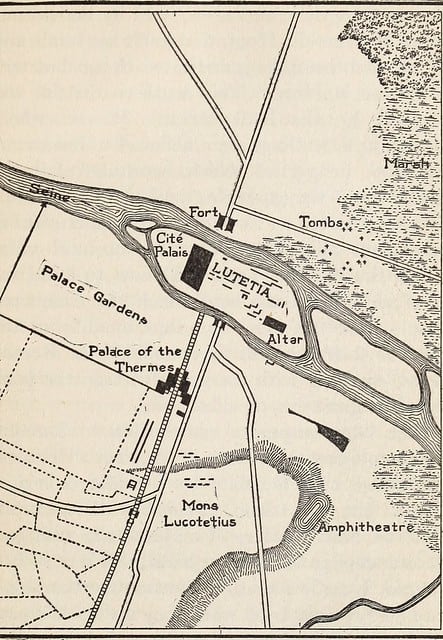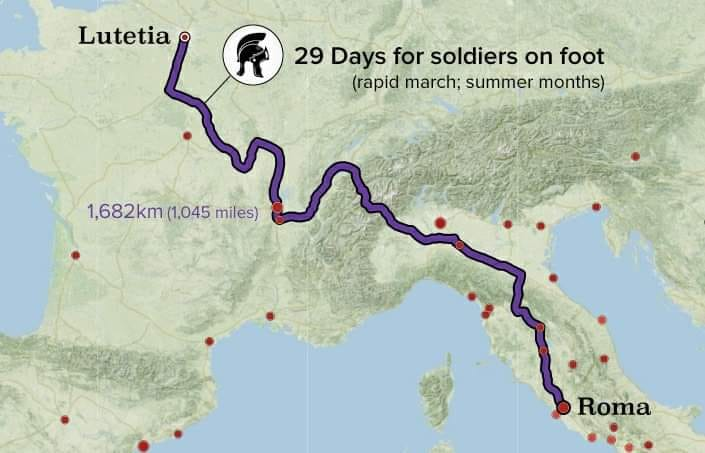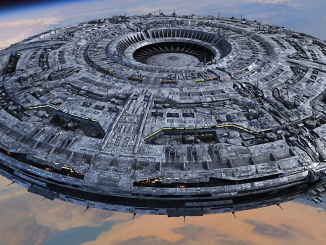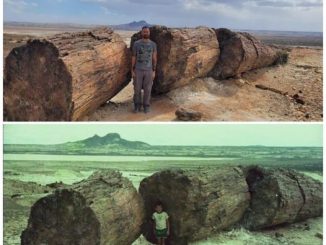1.”Unraveling the Incredible Speed of Roman Legion Marches: Lutetia (Paris) to Rome in 29 Days”

Introduction: The Roman Empire’s military prowess and logistical capabilities have long fascinated historians, particularly when it comes to the rapid movement of Roman legions across vast distances. One remarkable feat that stands out is the swift march from Lutetia (modern-day Paris) to Rome, covering an astounding 1682 kilometers in just 29 days. This incredible journey, undertaken by fully laden Roman legions, sheds light on the strategic mobility and organizational efficiency of the Roman military machine during its peak.
The Fast-paced Journey of Roman Legions Imagine Roman legions on a mission, marching at a relentless pace of 59 kilometers per day, carrying up to 46 kilograms of weight each. This extraordinary speed was achieved under optimal conditions during comfortable summer weather, with minimal disruptions such as rain or military ambushes. Such rapid movement underscores the disciplined training, physical endurance, and logistical planning of Roman soldiers and their supporting personnel.

Logistical Challenges and Adaptations The success of these rapid marches was not without challenges. The logistical support required to sustain a legion on the move was immense, encompassing baggage trains, engineers, cooks, slaves, and auxiliary cavalry. The cavalry played a crucial role in scouting ahead, ensuring the safety of the legion’s advance and minimizing risks of ambushes. Baggage wagons had to be carefully managed to prevent overloading and minimize the risk of mechanical failures during the arduous journey.
Implications for Military Strategy and Archaeology The ability of Roman legions to cover vast distances in short periods had profound implications for military strategy and operations. The rapid deployment of troops enabled swift responses to threats or uprisings across the empire. Archaeological evidence, including ancient road networks, military camps, and logistical remains, provides valuable insights into how the Roman military managed such expeditions and maintained supply lines over long distances. These artifacts contribute to our understanding of ancient military tactics and the logistical capabilities of the Roman Empire.
In conclusion, the remarkable speed and efficiency of Roman legion marches from Lutetia to Rome exemplify the strategic mobility and organizational prowess of the Roman military. This feat required meticulous planning, disciplined execution, and effective logistical support to sustain the troops over vast distances. The study of Roman military campaigns and expeditions not only showcases the empire’s military might but also highlights the enduring legacy of Roman engineering, logistics, and strategic thinking. Archaeological discoveries continue to unveil the complexities of ancient warfare and shed light on the remarkable achievements of the Roman legions in antiquity.

2. March of History: Tracing the Rapid March from Lutetia to Roma
The ancient world was marked by extraordinary feats of engineering, culture, and military prowess, with Roman soldiers embodying much of this spirit. A striking demonstration of Roman military efficiency is encapsulated in the journey from Lutetia (modern-day Paris) to Roma (modern-day Rome). According to historical data, Roman soldiers could cover this extensive route of 1,682 kilometers (1,045 miles) in just 29 days by foot during the summer months, a testament to their remarkable endurance and strategic planning.
The Route and Its Strategic Importance
The route, as depicted in the map, winds through various terrains, showcasing the geographical challenges that the Roman legionaries faced. Starting from Lutetia, the heart of the Parisii tribe, the path snakes southward, cutting through the diverse landscapes of what is now modern France and Italy. Each purple segment and red dot on the map represents critical waypoints and settlements where troops could restock, rest, and receive reinforcements.
The Rigors of the March
The journey from Lutetia to Roma was not just a demonstration of physical stamina but also of logistical efficiency. Roman soldiers, renowned for their discipline, marched under the harsh sun in tightly organized cohorts, ensuring rapid movement and readiness for combat. The “rapid march” mentioned in the map highlights this capability, optimized for moving troops swiftly across great distances to maintain Rome’s influence and control throughout the empire.
The Roman Military Machine
The ability to mobilize and deploy forces quickly was a cornerstone of Roman military strategy. The soldiers, often carrying up to 45 pounds of armor and supplies, were not only warriors but also skilled engineers who constructed camps and fortifications along their routes. This march from Lutetia to Roma would have required careful preparation, with supply lines and logistics meticulously managed to support the swift pace of the legionaries.
Historical and Cultural Impact
The connectivity between distant parts of the Roman Empire facilitated not only military expeditions but also economic exchange and cultural integration. Roads built to move armies became trade routes, helping to assimilate conquered territories into the Roman economic sphere. The route from Lutetia to Roma symbolizes this integration, bridging the northern and southern parts of the empire.
Conclusion
The map depicting the march from Lutetia to Roma is more than a historical route; it is a narrative of Roman tenacity and strategic acumen. As modern observers trace this path, they gain insights into the logistical foundations of one of history’s most formidable military forces. This march not only represents a military campaign but also illustrates the broader impacts of Roman infrastructure and organization, which continue to influence military and civil planning to this day.


